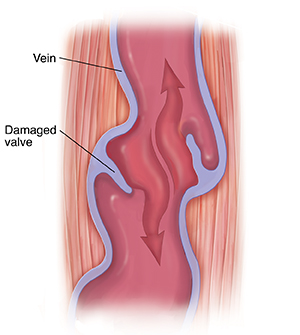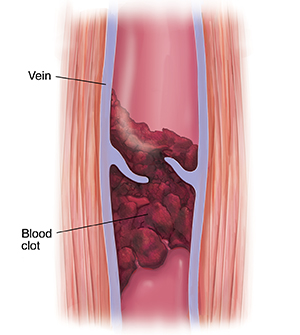Venous Ulcers
Understanding Chronic Venous Insufficiency
Problems with the veins in the legs may lead to chronic venous insufficiency (CVI). CVI means that there's a long-term problem with the veins not being able to pump blood back to your heart. When this happens, blood stays in the legs. This causes leg swelling and aching.
Two problems that may lead to CVI are:
-
Damaged valves. Valves keep blood flowing from the legs through the blood vessels and back to the heart. When the valves are damaged, blood doesn't flow as well.
-
Deep vein thrombosis). Blood clots may form in the deep veins of the legs. This may cause leg pain, redness, and swelling. It may also block the flow of blood back to the heart. Get medical care right away if you have these symptoms.


Call 911
A blood clot in the leg can also break off and travel to the lungs. This is called a pulmonary embolism (PE). In the lungs, the clot can cut off blood flow. This is a medical emergency and may cause death. Call 911 right away if you have these symptoms of a PE:
- Chest pain
- Trouble breathing
- Fast heartbeat
- Fainting
Knowing the symptoms
Be aware of the following:
-
If you stand or sit with your feet down for a long time, your legs may ache or feel heavy.
-
Swollen ankles (very common)
-
As swelling increases, the skin over your ankles may:
- Show red spots or a brownish tinge
- Feel leathery or scaly
- Start to itch
-
If swelling isn't controlled, an open sore may form.
What you can do
CVI can’t be cured. But controlling leg swelling can reduce the risk of sores. Follow these tips:
-
Increase blood flow back to your heart by:
- Raising (elevating) your legs
- Exercising daily
- Wearing elastic (compression) stockings
-
Boost blood flow in your legs by losing extra weight.
-
Maintain good skin care.
-
If you must stand or sit in one place for a long time, keep your blood moving by:
- Wiggling your toes
- Shifting your body position
- Rising up on the balls of your feet
- Wearing compression stockings
Treating Ulcers
Chronic Venous Insufficiency: Treating Ulcers
If leg swelling because of chronic venous insufficiency isn’t controlled, an open wound (ulcer) can form. Ulcers vary in size and shape. But they usually appear on the inside of the ankle.
Treating an ulcer

-
See your healthcare provider. Ulcers need frequent medical care. Special dressings may be applied. You may be given antibiotics to fight infection.
-
Your provider may prescribe medicines, such as aspirin or pentoxifylline, to help the ulcer heal.
-
Your provider may prescribe compression stockings to help with the swelling.
-
Raise (elevate) your legs often to reduce swelling. The ulcer needs oxygen-rich blood to heal. This blood can’t reach the ulcer until swelling is reduced.
When to call your healthcare provider
Call your healthcare provider right away if you have any of the following:
-
More pain
-
Fever of 100.4°F (38°C) or higher, or as directed by your provider
-
The area around the ulcer becomes red, sore, or both
-
The ulcer oozes discolored fluid or smells bad
-
Swelling increases suddenly or the dressing feels tight
Providers

Erick Jose Guerra, MD
